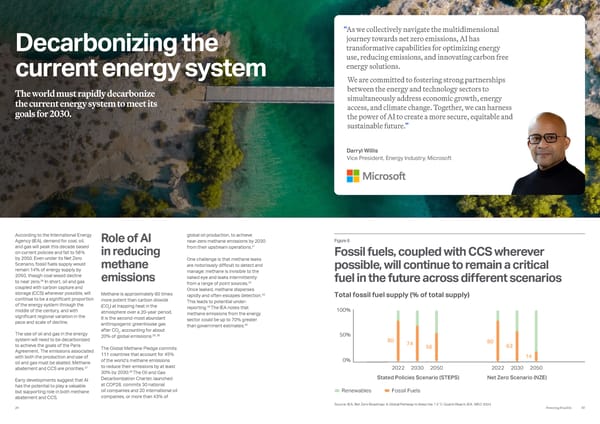Figure 8 Fossil fuels, coupled with CCS wherever possible, will continue to remain a critical fuel in the future across different scenarios Total fossil fuel supply (% of total supply) Renewables Fossil Fuels 2022 2030 Stated Policies Scenario (STEPS) Net Zero Scenario (NZE) 2050 2022 2030 2050 80 74 56 100% 0% 50% 80 63 14 Source: IEA, Net Zero Roadmap: A Global Pathway to Keep the 1.5˚C Goal in Reach; IEA, WEO 2024 global oil production, to achieve near-zero methane emissions by 2030 from their upstream operations.41 One challenge is that methane leaks are notoriously difficult to detect and manage: methane is invisible to the naked eye and leaks intermittently from a range of point sources.42 Once leaked, methane disperses rapidly and often escapes detection.43 This leads to potential under- reporting.44 The IEA notes that methane emissions from the energy sector could be up to 70% greater than government estimates.45 Decarbonizing the current energy system According to the International Energy Agency (IEA), demand for coal, oil, and gas will peak this decade based on current policies and fall to 56% by 2050. Even under its Net Zero Scenario, fossil fuels supply would remain 14% of energy supply by 2050, though coal would decline to near zero.36 In short, oil and gas coupled with carbon capture and storage (CCS) wherever possible, will continue to be a significant proportion of the energy system through the middle of the century, and with significant regional variation in the pace and scale of decline. The use of oil and gas in the energy system will need to be decarbonized to achieve the goals of the Paris Agreement. The emissions associated with both the production and use of oil and gas must be abated. Methane abatement and CCS are priorities.37 Early developments suggest that AI has the potential to play a valuable but supporting role in both methane abatement and CCS. The world must rapidly decarbonize the current energy system to meet its goals for 2030. Methane is approximately 80 times more potent than carbon dioxide (CO2) at trapping heat in the atmosphere over a 20-year period. It is the second-most abundant anthropogenic greenhouse gas after CO2, accounting for about 20% of global emissions.38, 39 The Global Methane Pledge commits 111 countries that account for 45% of the world’s methane emissions to reduce their emissions by at least 30% by 2030.40 The Oil and Gas Decarbonization Charter, launched at COP28, commits 30 national oil companies and 20 international oil companies, or more than 43% of Role of AI in reducing methane emissions Darryl Willis Vice President, Energy Industry, Microsoft “ As we collectively navigate the multidimensional journey towards net zero emissions, AI has transformative capabilities for optimizing energy use, reducing emissions, and innovating carbon free energy solutions. We are committed to fostering strong partnerships between the energy and technology sectors to simultaneously address economic growth, energy access, and climate change. Together, we can harness the power of AI to create a more secure, equitable and sustainable future.” 30 Powering Possible 29
 Powering Possible 2024: AI and Energy for a Sustainable Future Page 15 Page 17
Powering Possible 2024: AI and Energy for a Sustainable Future Page 15 Page 17